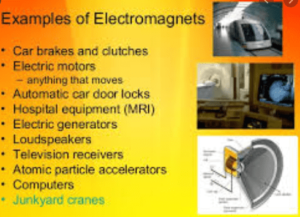Electromagnetism Examples
Electromagnetism is a branch of physics that deals with a unifying theory from the fields of both electricity and magnetism, to formulate one of the four fundamental forces of the universe known so far: electromagnetism. The other fundamental forces are gravity and strong and weak nuclear interactions.
Electromagnetism is a field theory, that is, based on vector or tensor physical magnitudes, which depend on the position in space and time. It is based on four-vector differential equations (formulated by Michael Faraday and developed for the first time by James Clerk Maxwell, for which they were baptized as Maxwell’s equations ) that allow the joint study of electric and magnetic fields, as well as electric current, electrical polarization, and magnetic polarization.
On the other hand, electromagnetism is a macroscopic theory. This means that it studies large electromagnetic phenomena, applicable to high numbers of particles and considerable distances since at the atomic and molecular levels it gives way to another discipline, known as quantum mechanics.
Examples of electromagnetism
Examples of equipment or situations based on electromagnetism are given below:
- Kitchen Microwave

- Transformers
- Magnetic card readers
- Pendrives
- MRI equipment for medical studies
- Microphones
- Planes
- Digital cameras
- Cell phones
- Thermometers
- Optical instruments
- Magnets
- Compasses
- Irons
- Ultrasound equipment
- Oscilloscopes
- Mass spectrometers
- Modems
- Tomographs
- Mammographs
Features
Electromagnetism is concerned with describing the physical phenomena macroscopic in which electric charges are involved, both at rest and in motion. It is clear, then, that it does not describe phenomena on an atomic or molecular scale; to do it in such detail, it is necessary to resort to other disciplines, such as quantum mechanics.
Electromagnetic waves are known to travel in a vacuum at the speed of light and are capable of transporting energy through space. The amount of energy carried by an electromagnetic wave depends on its frequency.
Applications of electromagnetism
- Doorbells. The mechanism of these everyday gadgets involves the circulation of an electric charge by an electromagnet, whose magnetic field attracts a tiny metal hammer to a bell, interrupting the circuit and allowing it to start again, so the hammer repeatedly hits it and produces the sound that catches our attention.
- Magnetic suspension trains. Instead of rolling on rails like conventional trains, this ultra-technological train model is held in magnetic levitation by powerful electromagnets installed on its underside. Thus, the electrical repulsion between the magnets and the metal of the platform on which the train circulates maintains the weight of the vehicle in the air.
- Electric transformers. A transformer, those cylindrical devices that in some countries we see on power lines, serve to control (increase or decrease) the voltage of an alternating current. This is achieved through coils arranged around an iron core, whose electromagnetic fields allow modulating the intensity of the outgoing current.
- Electric motors. Motors, as we all know, transform energy into motion, using a combination of a rotor and a stator. The first is mobile and contains a series of coils, which are located between the fixed poles of the magnet that is the choke. This movement is kept constant thanks to the electromagnetic field and allows, by means of a switch, to produce a turn that moves the vehicle forward.
- We dynamos them. These devices serve to take advantage of the rotation of the wheels of a vehicle, such as an automobile, to rotate a magnet and produce a magnetic field that supplies alternating current to the coils.
- The phone. The magic behind this everyday device is none other than the ability to convert sound waves (such as voice) into modulations of an electromagnetic field that can be transmitted, initially by a cable, to a receiver at the other end that is capable of pouring the process and recover electromagnetically contained sound waves.
- Microwave ovens. These appliances operate from the generation and concentration of electromagnetic waves on the food. These waves are similar to those used for radio communication, but of a high frequency that rotates the diploids (magnetic particles) of the food at very high speeds since they try to align with the resulting magnetic field. This movement is what generates the heat.
- Magnetic resonance imaging (MRI). This medical application of electromagnetism has been an unprecedented advance in health, since it allows non-invasively examining the inside of the body of living beings, from the electromagnetic manipulation of the hydrogen atoms contained in it, to generate a field interpretable by specialized computers.
- Microphones. These devices so common today operate thanks to a diaphragm attracted by an electromagnet, whose sensitivity to sound waves allows them to be translated into an electrical signal. This, later, can be transmitted and deciphered remotely, or even be stored and reproduced later.
- Mass spectrometers. It is a device that allows the composition of certain chemical compounds to be analyzed with great precision, based on the magnetic separation of the atoms that make them up, by means of their ionization and reading by a specialized computer.
- Oscilloscopes. Electronic instruments whose task is to graphically represent the time-varying electrical signals from a specific source. To do this they use a coordinate axis on the screen whose lines are the product of the measurement of the voltages from the determined electrical signal. They are used in medicine to measure the functions of the heart, brain, or other organs.
- Magnetic cards. This technology allows the existence of credit or debit cards, which have a specially polarized magnetic tape, to encrypt information based on the orientation of its ferromagnetic particles. By inserting information into them, the designated devices polarize said particles in a specific way, so that said order can then be “read” to retrieve the information.
- Digital storage on magnetic tapes. Key in the world of computing and computers, it allows large amounts of information to be stored on magnetic disks whose particles are polarized in a specific way and decipherable by a computerized system. These disks can be removable, like the pen drives or the already extinct diskettes, or they can be permanent and of greater complexity, like the hard disks.
- Magnetic drums. This model of data storage, popular in the 1950s and 1960s, was one of the first forms of magnetic data storage. It is a hollow metal cylinder that spins at high speeds, surrounded by a magnetic material (iron oxide) on which the information is printed using a coded polarization system. Unlike discs, it did not have a reading head and that allowed it to be quick to retrieve information.
- Bicycle lights. The lights built into the front of the bikes, which come on when traveling, operate thanks to the spinning of the wheel to which a magnet is attached, the spinning of which produces a magnetic field and therefore a modest source of alternating electricity. Said electric charge is then led to the light bulb and translated into light.
Related Topics:
- Electricity and Magnetism
- Faraday’s law
- Lenz’s law
- Transformer
- Electric motors
- Difference between self-induction and mutual induction
- Electromagnetic waves
